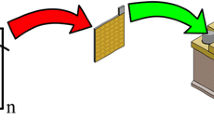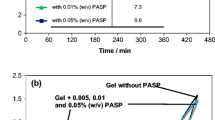Abstract
A novel silicate-based protective film was formed on negative electrodes and compared of the performance in various electrolyte systems of lead-acid batteries. The sodium silicate-based coating for the negative electrode component of a gel valve-regulated lead-acid (gel-VRLA) battery was applied for the first time in the literature. The battery system was produced by sodium silicate-coated negative electrodes and lead oxide positive electrodes in various kinds of electrolyte. Electrochemical characterization of cells and battery prototypes were done by cyclic voltammetric (CV) analysis, electrochemical impedance spectroscopic (EIS) analysis, and cyclic charge-discharge tests. The surface morphologies of silicate-coated electrodes were investigated by scanning electron microscopic analysis after cyclic voltammetric analysis and charge-discharge tests. The coating of silicate on the surface of negative electrodes increased the corrosion resistance of a VRLA battery according to the Tafel polarization curves. Indeed, sulfation on the negative electrode component of the battery have significantly reduced with silicate coatings of them. Besides, the prepared novel silicate-based protective film have increased the battery performance of a VRLA. Silicate-based coatings for electrodes can be used for industrial battery production for many different battery types due to their amazing anti-corrosion properties in acidic media.









Similar content being viewed by others
References
Lukic SM, Cao J, Bansal RC et al (2008) Energy storage systems for automotive applications. IEEE Trans Ind Electron 55:2258–2267
Newnham RH, Baldsing WGA (1997) Performance of flooded- and gelled-electrolyte lead/acid batteries under remote-area power-supply duty. J Power Sources 66:27–39
Chang Y, Mao X, Zhao Y, Feng S, Chen H, Finlow D (2009) Lead-acid battery use in the development of renewable energy systems in China. J Power Sources 191:176–183
Daniel C, Besenhard JO (2011) Handbook of battery materials: Second Edition. Handb Batter Mater Second Ed
Hernández JC, Soria ML, González M, García-Quismondo E, Muñoz A, Trinidad F (2006) Studies on electrolyte formulations to improve life of lead acid batteries working under partial state of charge conditions. J Power Sources 162:851–863
Tian X, Gong Y, Wu Y, Agyeiwaa A, Zuo T (2014) Management of used lead acid battery in China: secondary lead industry progress, policies and problems. Resour Conserv Recycl 93:75–84
Bernardes AM, Espinosa DCR, Tenorio JAS (2004) Recycling of batteries: a review of current processes and technologies. J Power Sources 130:291–298
Genaidy AM, Sequeira R, Tolaymat T et al (2008) An exploratory study of lead recovery in lead-acid battery lifecycle in US market: an evidence-based approach. Sci Total Environ 407:7–22
Chen HY, Li AJ, Finlow DE (2009) The lead and lead-acid battery industries during 2002 and 2007 in China. J Power Sources 191:22–27
Tantichanakul T, Chailapakul O, Tantavichet N (2011) Gelled electrolytes for use in absorptive glass mat valve-regulated lead-acid (AGM VRLA) batteries working under 100% depth of discharge conditions. J Power Sources 196:8764–8772
Gençten M, Dönmez KB, Şahin Y, Pekmez K, Suvacı E (2014) Voltammetric and electrochemical impedimetric behavior of silica-based gel electrolyte for valve-regulated lead-acid battery. J Solid State Electrochem 18(2014):2469–2479
Dönmez KB, Gençten M, Şahin Y (2017) A novel polysiloxane-based polymer as a gel agent for gel–VRLA batteries. Ionics (Kiel) 23:2077–2089
Lambert DWH, Greenwood PHJ, Reed MC (2002) Advances in gelled-electrolyte technology for valve-regulated lead-acid batteries. J Power Sources 107:173–179
Tang Z, Wang J, xian MX et al (2007) Investigation and application of polysiloxane-based gel electrolyte in valve-regulated lead-acid battery. J Power Sources 168:49–57
Vinod MP, Vijayamohanan K (2000) Effect of gelling on the impedance parameters of Pb/PbSO4 electrode in maintenance-free lead-acid batteries. J Power Sources 89:88–92
Vinod MP, Vijayamohanan K, Joshi SN (1998) Effect of silicate and phosphate additives on the kinetics of the oxygen evolution reaction in valve-regulated lead/acid batteries. J Power Sources 70:103–105
Vinod MP, Mandle AB, Sainkar SR, Vijayamohanan K (1997) Effect of gelling on the surface structure of a porous lead electrode in sulfuric acid. Langmuir 27:462–468
Bergna HE, Colloid T (1994) The colloid chemistry of silica. Advances 234:695
Prengaman RD (2001) Challenges from corrosion-resistant grid alloys in lead acid battery manufacturing. J Power Sources 95:224–233
Ruetschi P (2004) Aging mechanisms and service life of lead-acid batteries. J Power Sources 127:33–44
Lopez-Garrity O, Frankel GS (2014) Synergistic corrosion inhibition of AA2024-T3 by sodium silicate and sodium molybdate. ECS Electrochem Lett 3:C33–C35
Lopez-Garrity O, Frankel GS (2014) Corrosion inhibition of aa2024-t3 by sodium silicate. Electrochim Acta 130:9–21
Lopez-Garrity O, Frankel GS (2014) Corrosion inhibition of aluminium alloy 2024-T3 by sodium molybdate. J Electrochem Soc 3:C95–C106
rong YM, J tang L, Kong G (2010) Effect of SiO2:Na2O molar ratio of sodium silicate on the corrosion resistance of silicate conversion coatings. Surf Coatings Technol 204:1229–1235
Lin B l., Lu J tang, Kong G (2008) Synergistic corrosion protection for galvanized steel by phosphating and sodium silicate post-sealing. Surf Coatings Technol 202:1831–1838
Şahin Y, Dönmez KB, Gençten M, et al (2016) Sodyum silikat temelli membran ile kaplı bir elektrot ve üretim yöntemi, Turkish patent and trademark office Patent no: 201402946
Hämeenoja E, Laitinen T, Sundholm G, Yli-Pentti A (1989) The growth of oxide layers on lead and its alloys at a constant potential in the PbO2 potential region at different temperatures. Electrochim Acta 34:233–241
Bullock KR (2010) Carbon reactions and effects on valve-regulated lead-acid (VRLA) battery cycle life in high-rate, partial state-of-charge cycling. J Power Sources 195:4513–4519
Muneret X, Gobé V, Lemoine C (2005) Influence of float and charge voltage adjustment on the service life of AGM VRLA batteries depending on the conditions of use. J Power Sources 144:322–328
Pavlov D, Papazov G, Monahov B (2003) Strap grid tubular plate—a new positive plate for lead-acid batteries. Processes of residual sulphation of the positive plate In: J Power Sources 113:255–270
Wu L, Chen HY, Jiang X (2002) Effect of silica soot on behaviour of negative electrode in lead-acid batteries. J Power Sources 107:162–166
Gencten M, Gursu H, Sahin Y (2017) Effect of α- and γ-alumina on the precipitation of positive electrolyte in vanadium redox battery. Int J Hydrog Energy 42:25598–25607
Gencten M, Gursu H, Sahin Y (2017) Anti-precipitation effects of TiO2 and TiOSO4 on positive electrolyte of vanadium redox battery. Int J Hydrogen Energy Int J Hydrogen Energy 42:25608–25618
Gençten M, Gürsu H, Şahin Y (2015) Electrochemical investigation of the effects of V(V) and sulfuric acid concentrations on positive electrolyte for vanadium redox flow battery. Int J Hydrog Energy 41:9868–9875
Pavlov D, Petkova G, Rogachev T (2008) Influence of H2SO4 concentration on the performance of lead-acid battery negative plates. J Power Sources 175:586–594
Pavlov D, Naidenov V, Ruevski S (2006) Influence of H2SO4 concentration on lead-acid battery performance. H-type and P-type batteries J Power Sources 161:658–665
Pavlov D, Petkova G, Dimitrov M, Shiomi M, Tsubota M (2000) Influence of fast charge on the life cycle of positive lead-acid battery plates. J Power Sources 87:39–56
Calábek M, Micka K, Křivák P, Bača P (2006) Significance of carbon additive in negative lead-acid battery electrodes. J Power Sources 158:864–867
Zhang B, Zhong J, Li W, Dai Z, Zhang B, Cheng Z (2010) Transformation of inert PbSO4 deposit on the negative electrode of a lead-acid battery into its active state. J Power Sources 195:4338–4343
Pavlov D, Nikolov P, Rogachev T (2011) Influence of carbons on the structure of the negative active material of lead-acid batteries and on battery performance. J Power Sources 196:5155–5167
Pavlov D, Popova R (1970) Mechanism of passivation processes of the lead sulphate electrode. Electrochim Acta 15:1483–1491
Salih S, Gad-Allah A, Abd El-Wahab A, Abd El-Rahman H (2014) Effect of boric acid on corrosion and electrochemical performance of Pb-0.08% Ca-1.1% Sn alloys containing Cu, As, and Sb impurities for manufacture of grids of lead-acid batteries. Turkish J Chem 38:260–274
Khatbi S, Gouale Y, Mansour S, Lamiri A (2018) Electrochemical and metallurgical behavior of lead-aluminum casting alloys as grids for lead-acid batteries. Port Electrochim Acta 36:133–146
Tang Z, Wang JM, Mao XX, Chen QQ, Shen C, Zhang JQ (2007) Application of a novel gelled-electrolyte in valve-regulated lead-acid batteries with tubular positive plates. J Appl Electrochem 37:1163–1169
Acknowledgements
This work was supported by the SAN-TEZ program (No. 00897.STZ.2011-1) of Ministry of Science, Industry and Technology, Republic of Turkey, with Anadolu University, and Ericsson Turkey. Y. Şahin thanks Prof. Dr. Kadir Pekmez, Prof. Dr. Ender Suvacı, and Oktay Uysal for their support to this study. M. Gençten thanks TUBİTAK-BİDEB.
Author information
Authors and Affiliations
Corresponding author
Rights and permissions
About this article
Cite this article
Dönmez, K.B., Gençten, M. & Şahin, Y. A performance comparison of protective silicate-coated lead and non-coated lead electrodes in various kind electrolytes of gel valve-regulated lead-acid battery. Ionics 24, 3655–3664 (2018). https://doi.org/10.1007/s11581-018-2551-1
Received:
Accepted:
Published:
Issue Date:
DOI: https://doi.org/10.1007/s11581-018-2551-1




